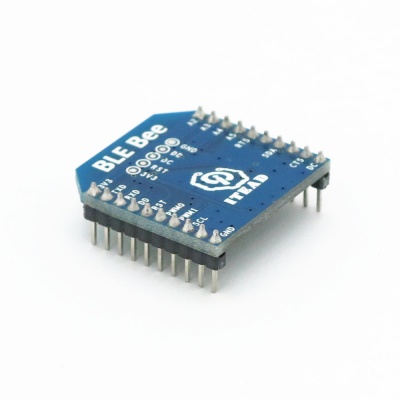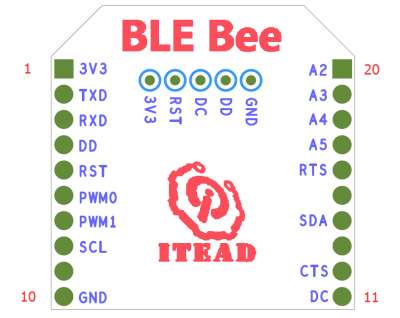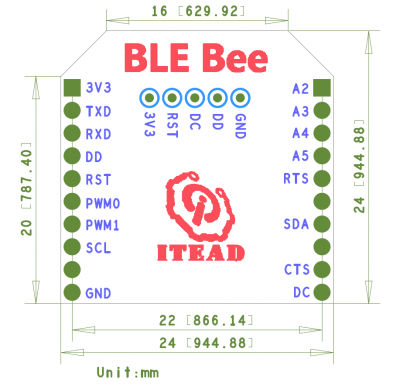Difference between revisions of "BLE Bee"
m (→Overview) |
m (→Revision History) |
||
| Line 30: | Line 30: | ||
|- | |- | ||
| V1.1||Add GPIO function; | | V1.1||Add GPIO function; | ||
| − | + | ||
| − | + | Add ADC function; | |
| − | + | ||
| − | + | Add remote GPIO & ADC control. | |
| − | + | ||
| − | + | Add error messages’ instruction for users to check. | |
| + | ||2015-06-19 | ||
|} | |} | ||
| align="center" style="background:#f0f0f0;"|'''Parameter''' | | align="center" style="background:#f0f0f0;"|'''Parameter''' | ||
Revision as of 06:50, 7 July 2015
Contents
- 1 Overview
- 2 Specifications
- 3 Electrical Characteristics
- 4 Revision History
- 5 Hardware
- 6 Pinmap
- 7 Software
- 8 At Commands
- 8.1 1.Test command
- 8.2 2.Show version command
- 8.3 3.Restart command
- 8.4 4.Baudrate command
- 8.5 5.Peripheral name command
- 8.6 6.Central name command
- 8.7 7.Peripheral passcode command
- 8.8 8.Central passcode command
- 8.9 9.Central and peripheral switch command
- 8.10 10.Status command
- 8.11 11.Peripheral advertise command
- 8.12 12.Peripheral terminate command
- 8.13 13.Central RSSI command
- 8.14 14.AT mode send command
- 8.15 15.AT mode and DATA mode switch command
- 8.16 16.Debug command
- 8.17 17.GPIO SET command
- 8.18 18.GPIO write command
- 8.19 19.GPIO read command
- 8.20 20.ADC IO set command
- 8.21 21.ADC reference command
- 8.22 22.ADC read command
- 9 Error Messages
- 10 Download
Overview
BLE Bee ITDB031 is a serial port BLE module. It is based on TI’s CC2541 BLE chip. With it you can transfer data wirelessly and do remote control. It supports both central mode and peripheral mode. And It supports remote control to the other side which is connected. Also it can a support custom commands when you combine it with other devices. The BLE Bee is compatible with XBee socket. You can just plug it onto the XBee socket.
Note: The serial interfaceis 3.3v, not the typical 5v as on many Arduino boards - anyone using an alternative to the Foca board must take note not to risk damage.
Specifications
| Microprocessor | CC2541 |
| PCB size | 24mm X 24mm X 1.6mm |
| Power supply | 3.3V |
Electrical Characteristics
| Rev. | Description | Release date |
| v1.0 | Initial version | 2015-06-11 |
| V1.1 | Add GPIO function;
Add ADC function; Add remote GPIO & ADC control. Add error messages’ instruction for users to check. |
2015-06-19 |
Hardware
Pinmap
| Idex | Name | Pin of ITDB031 | Name of ITDB031 |
| 1 | 3V3 | P11 | VCC_IN |
| 2 | TXD | P7 | P1_5 |
| 3 | RXD | P8 | P1_4 |
| 4 | DD | P2 | P2_1 |
| 5 | RST | P17 | RESET |
| 6 | PWMO | P4 | P1_6 |
| 7 | PWM1 | P3 | P1_7 |
| 8 | SCL | P5 | SCL |
| 9 | NC | - | - |
| 10 | GND | P12 | GND |
| 11 | DC | P1 | P2_2 |
| 12 | GTS | P10 | P1_2 |
| 13 | NC | - | - |
| 14 | SDA | P6 | SDA |
| 15 | NC | - | - |
| 16 | RTS | P9 | P1_3 |
| 17 | A5 | P13 | P0_5 |
| 18 | A4 | P14 | P0_4 |
| 19 | A3 | 15 | P0_3 |
| 20 | A2 | P16 | P0_2 |
Note:
- The default uart interface is USART0’s P1_4(RX) and P1_5(TX).
- The debug interface can be used to re-program the CC2541 chip.
- Except uart, I2C and debug interface , other pins are default GPIO input.
- Except uart and debug interface, other pins can not be used with current software.
Software
The current software supports central mode and peripheral mode. One ITDB031 can only be in one mode at one time. This can be switched by AT commands. Each ITDB031 has two names. One is peripheral name. This name is used for peripheral device to advertise, telling that who it is. And this name can be scanned by a central device before a connection starts. The other name is connecting name. This name is used to match the peripheral name, when one ITDB031 turns into central mode and starts a connection. This name is used by a central device, telling whom it will connect to. When the two names are matched, a connection can be build. At current time one central device can only connect one peripheral device. Similarly, each ITDB031 has two passcodes. One is peripheral passcode and the other is central passcode. A central device sends its central passcode to a peripheral device when the peripheral requests a connecting passcode. If the central passcode which a central sends matches the peripheral passcode which a peripheral has, the connection is build. Otherwise, the peripheral can terminate the connection.
At Commands
Factory default setting: Peripheral Name: Itead Central Name: Itead Peripheral passcode: 0 (means that no passcode needed) Uart: baudrate 9600, N, 8, 1, ADC reference: 0 (1.25V)
AT commands’ format: Each command with its parameter is a string. And every command must end with either '\r' or '\n'.
Command's parameter starts with a '=' .
Command's return is also a string , which ends with '\0'. For example: AT\n or AT\r AT+DATA=1\n or AT+DATA=0\r
AT commands’ mode: AT MODE: Almost all the AT commands can be executed in this mode. DATA MODE: The data inputted from uart is directly transported to the other side’s uart. Only one command can be executed to quit this DATA mode.
Commands:
1.Test command
| Command | Respond | Parameter |
| AT\n | OK\n\0 | none |
This command is used to test current local uart connection.
2.Show version command
| send | receive | parameter |
| ON\n | Version\n\0 | none |
This command is to show the current softeware version.
3.Restart command
| send | receive | parameter |
| AT+RESTART\n | none | none |
This command is for restarting the device.
4.Baudrate command
| send | receive | parameter |
| AT+BAUD= | OK:0\n\0 | 0\n |
| OK:1\n\0 | 1\n | |
| OK:2\n\0 | 2\n | |
| OK:3\n\0 | 3\n | |
| OK:4\n\0 | 4\n | |
| OK:B:baudrate\n\0 | ?\n |
This command is to set baudrate :
0---- >baudrate 9600
1---- >baudrate 19200
2---- >baudrate 38400
3---- >baudrate 57600
4---- >baudrate 115200
5.Peripheral name command
| send | receive | parameter |
| AT+PNAME= | OK\n\0 | Name\n |
| OK:name\n\0 | ?\n |
This command is to set peripheral name.
A peripheral name is a string that has less than 20 char data.
This name can be always stored regardless of power on or not.
6.Central name command
| send | receive | parameter |
| AT+CNAME= | OK\n\0 | Name\n |
| OK:name\n\0 | ?\n |
This command is to set central name.
A central name is a string that has less than 20 char data.
This name can be always stored regardless of power on or not.
7.Peripheral passcode command
| send | receive | parameter |
| AT+PPIN= | OK\n\0 | Passcode\n |
| OK\n\0 | 0\n | |
| OK:passcode\n\0 | ?\n |
This name is to set peripheral passcode.
A peripheral passcode is a 6-char string made up with ‘0’ ~ ‘9’.
For example: “012345”
When parameter is 0 , it means that there’s no passcode request during connecting.
8.Central passcode command
| send | receive | parameter |
| AT+PPIN= | OK\n\0 | Passcode\n |
| OK:passcode\n\0 | ?\n |
This name is to set central passcode.
A central passcode is a 6-char string made up with ‘0’ ~ ‘9’.
For example: “012345”
9.Central and peripheral switch command
| send | receive | parameter |
| AT+ROLE= | ready\n\0 | 1\n |
| OK\n\0 | 0\n |
This command is to switch device to be central or peripheral.
1--- > central
2--- > peripheral
When a device turns to be a central, It will auto discovery peripheral devices and auto connect the one who’s peripheral name matches its central name.
When a connection is build, both sides will receive string “ready\n\0”.
10.Status command
| send | receive | parameter |
| AT+STATUS= | N:name\n\0 | N\n |
| M:mode\n\0 | M\n | |
| S:state\n\0 | S\n | |
| B:baudrate\n\0 | B\n | |
| N:name\n\0
M:mode\n\0 S:state\n\0 B:baudrate\n\0 |
\n |
This command is used to show some information about the device:
N --- > peripheral name
M --- > peripheral or central
S --- >current system state
B --- >baudrate
This command can be for debug.
11.Peripheral advertise command
| send | receive | parameter |
| AT+ADVER= | OK\n\0 | 1\n |
| OK\n\0 | 0\n | |
| OK:1\n\0
OK:0\n\0 |
?\n |
This command is used for peripheral to start or stop advertising.
1 --- > start to advertise
0 --- > stop adverting
When a peripheral stop advertising, it can not be scanned or searched.
12.Peripheral terminate command
| send | receive | parameter |
| AT+PTERM\n | OK\n\0 | none |
This command is used for peripheral device to stop current connection.
13.Central RSSI command
| send | receive | parameter |
| AT+RSSI= | OK\n\0 | 1\n |
| OK\n\0 | 0\n |
This command is used for central device to get RSSI.
1 --- > get RSSI. The RSSI will show to uart every second.
0 --- > stop getting RSSI.
14.AT mode send command
| send | parameter | local receive | Remote receive |
| AT+Send= | AT\n | OK\n\0
AT+RECEIVE:OK\n |
AT+RECEIVE:AT\n |
| AT+VERSION\n | OK\n\0
AT+RECEIVE:version\n |
AT+RECEIVE:AT+VERSION\n | |
| AT+BAUD=0\n | OK\n\0
AT+RECEIVE:B:0\n |
AT+RECEIVE:AT+BAUD=0\n | |
| AT+BAUD=1\n | OK\n\0
AT+RECEIVE:B:1\n |
AT+RECEIVE:AT+BAUD=1\n | |
| AT+BAUD=2\n | OK\n\0
AT+RECEIVE:B:2\n |
AT+RECEIVE:AT+BAUD=2\n | |
| AT+BAUD=3\n | OK\n\0
AT+RECEIVE:B:3\n |
AT+RECEIVE:AT+BAUD=3\n | |
| AT+BAUD=4\n | OK\n\0
AT+RECEIVE:B:4\n |
AT+RECEIVE:AT+BAUD=4\n | |
| AT+BAUD=?\n | OK\n\0
AT+RECEIVE:B:baudrate\n |
AT+RECEIVE:AT+BAUD=?\n | |
| AT+RESTART\n | OK\n\0 | OK\n\0 | |
| String\n | OK\n\0 | AT+RECEIVE:string\n |
This command is used to send command or string to the other side in AT mode.
Not all the AT commands which can be sent and executed are list above. Like GPIO and ADC.
Users can use this command to send custom string to the other side to execute user’s own task.
15.AT mode and DATA mode switch command
| send | parameter | local receive | remote receive |
| AT+DATA= | 1\n | DT\n\0 | AT+RECEIVE:AT+DATA on\n
DT\n\0 |
| 0\n | AT\n\0 | AT+DATA 0\n
AT\n\0 |
This command is used to switch to AT MODE or DATA MODE.
1--- > enter DATA mode. This command can not be executed in DATA mode.
2--- > enter AT mode. This command can only be used executed in DATA mode.
When two devices are connected, they can be switched into DATA mode.
Either the central or the peripheral enter to DATA mode, both devices will enter DATA mode.
Either the central or the peripheral enter to AT mode, both devices will enter AT mode.
In DATA mode , data from one side uartcan be transported directly to the other side’s uart.
The “local” is that the side you input. The “remote” is the other side.
16.Debug command
| send | receive | parameter |
| AT+DB= | OK\n\0 | 1\n |
| OK\n\0 | 0\n | |
| OK:0\n\0
OK:1\n\0 |
?\n |
This command is used to set flag to show debug information or not.
0 ---> show debug information.
1--- > stop showing debug information
When 1 is set, more system debug information will show to uart.
17.GPIO SET command
| send | receive | parameter |
| AT+GPIOSET= | OK\n\0 | 1\n |
| OK\n\0 | 2\n | |
| OK\n\0 | 3\n | |
| OK\n\0 | 4\n | |
| OK\n\0 | 5\n | |
| OK\n\0 | 6\n | |
| OK\n\0 | 9\n | |
| OK\n\0 | 10\n | |
| OK\n\0 | 13\n | |
| OK\n\0 | 14\n | |
| OK\n\0 | 15\n | |
| OK\n\0 | 16\n |
This command is used to set a pin to GPIO.
The parameter number is the pin index in pinmap.
This command must be used before AT+IOWRITE and AT+IOREAD.
Whenever a pin is set to GPIO, the pin can’t be used as other functions.
18.GPIO write command
| send | receive | parameter |
| AT+GPIORD= | OK:0\n\0
OK:1\n\0 |
1\n |
| OK:0\n\0
OK:1\n\0 |
2\n | |
| OK:0\n\0
OK:1\n\0 |
3\n | |
| OK:0\n\0
OK:1\n\0 |
4\n | |
| OK:0\n\0
OK:1\n\0 |
5\n | |
| OK:0\n\0
OK:1\n\0 |
6\n | |
| OK:0\n\0
OK:1\n\0 |
9\n | |
| OK:0\n\0
OK:1\n\0 |
10\n | |
| OK:0\n\0
OK:1\n\0 |
13\n | |
| OK:0\n\0
OK:1\n\0 |
14\n | |
| OK:0\n\0
OK:1\n\0 |
15\n | |
| OK:0\n\0
OK:1\n\0 |
16\n |
This command is used to set a GPIO to output high or low.
The first number of parameter is the pin index in pinmap, and the second number is :
1 ---> output high
0 ---> output low
This command must be used after AT+GPIOSET.
19.GPIO read command
| send | receive | parameter |
| AT+GPIORD= | OK:0\n\0
OK:1\n\0 |
1\n |
| OK:0\n\0
OK:1\n\0 |
2\n | |
| OK:0\n\0
OK:1\n\0 |
3\n | |
| OK:0\n\0
OK:1\n\0 |
4\n | |
| OK:0\n\0
OK:1\n\0 |
5\n | |
| OK:0\n\0
OK:1\n\0 |
6\n | |
| OK:0\n\0
OK:1\n\0 |
9\n | |
| OK:0\n\0
OK:1\n\0 |
10\n | |
| OK:0\n\0
OK:1\n\0 |
13\n | |
| OK:0\n\0
OK:1\n\0 |
14\n | |
| OK:0\n\0
OK:1\n\0 |
15\n | |
| OK:0\n\0
OK:1\n\0 |
16\n |
This command is used to read a GPIO .
The number of parameter is the pin index in pinmap, and the return number is :
1 ---> high
0 ---> low
This command must be used after AT+GPIOSET.
20.ADC IO set command
| send | receive | parameter |
| AT+ADSET= | OK\n\0 | 13\n |
| OK\n\0 | 14\n | |
| OK\n\0 | 15\n | |
| OK\n\0 | 16\n |
This command is used to set an io to ADC function .
The number of parameter is the pin index in pinmap :
13 ---> P0_5 (A5)
14 ---> P0_4 (A4)
15 ---> P0_3 (A3)
16 ---> P0_2 (A2)
This command must be used before AT+ADREAD.
21.ADC reference command
| send | receive | parameter |
| AT+ADREF= | OK\n\0 | 0\n |
| OK\n\0 | 1\n | |
| OK:0\n\0
OK:1\n\0 |
?\n |
This command is used to set ADC referencevoltage.
The number of parameter :
0 --->internallygenerated voltage (1.25V) ,default.
1 --->AVDD5 (3.3V)
This command must be used before AT+ADREAD. And this command is optional.
Be careful that the ADC input voltage must not be higher than the reference voltage.
22.ADC read command
| send | receive | parameter |
| AT+ADREAD= | OK:0xRESULT\n\0 | 13\n |
| OK:0xRESULT\n\0 | 14\n | |
| OK:0xRESULT\n\0 | 15\n | |
| OK:0xRESULT\n\0 | 16\n |
This command is used to read an ADC channel.
The number of parameter is the pin index in pinmap :
13 ---> P0_5 (A5)
14 ---> P0_4 (A4)
15 ---> P0_3 (A3)
16 ---> P0_2 (A2)
This command must be used after AT+ADSET.
The ADC is 14-bit and this command gets the first 12-bit number.
The RESULT here is from 0~7FF in a string. For example ,”OK:0x7FF\n\0”“OK:0x0\n\0”. That 0x0 means the 0V and 0x7FF means the reference voltage.
Error Messages
Sometimes the commands above do not return correctly and show some messages in strings like “error:0x8A\n\0”. It means something is wrong. Here are the error strings and their meanings for you to check.
| Error string: | Message: |
| error:0x80\n\0 | Unknow input source. (Neither uart nor air) |
| error:0x81\n\0 | Unknown AT mode.(Neither AT nor DATA) |
| error:0x82\n\0 | AT command buffer is over flowed.(Send “AT\n” to check) |
| error:0x83\n\0 | Unknown AT command. |
| error:0x84\n\0 | Unknown Uartbaudrate. |
| error:0x86\n\0 | Unknown device’s mode.(Neither central nor peripheral) |
| error:0x87\n\0 | Input AT command’s parameter is wrong. |
| error:0x88\n\0 | Fail to read scanRspData. |
| error:0x89\n\0 | Fail to read devicename. |
| error:0x8A\n\0 | Input IO index is wrong. |
| error:0x8B\n\0 | Input IO index has been used as other functions. |
Download
File:IM150611001-BLE Bee-datasheet.pdf
File:IM150611001-BLE Bee-dimension.pdf
File:IM150611001-BLE Bee-schematic.pdf
 Notice
Notice

